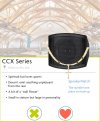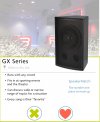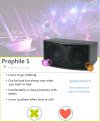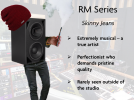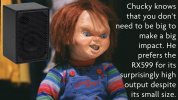Inspired by this thread, I thought I would share how companies can make their equipment seem amazing (when it isn't) without technically lying.
I used to do this as a significant part of my job. I was careful never to lie about anything, but I had to make the product sound as impressive as possible. There is an arms race between you and all of your (often even less scrupulous) competitors to make the gear sound impressive.
The process is not complicated, but does require cunning, creativity, just enough technical knowledge to be dangerous, and a certain mercenary disregard for the quality of forthrightness.
My goal here is to perhaps help people recognize the pattern. Many or most of you will notice when this is going on already... but in case it's helpful:
1. Pick literally any component of your product.
It's really not important where you start, as long as you can draw an apparently logical connection to something the customer cares about, about 8/10 times this will be sound quality, the other two will be reliability.
2. Identify an attribute of that component that is different, or failing that, an attribute that is completely standard, but the consumer doesn't know what it is.
In speakers this will often be a detail of the drivers, cabinet, or (in actives) the DSP or amplifiers.
3. Determine (or invent) what role that component has in producing sound (or reliability).
It doesn't need to be audible, it doesn't even need to be intentionally part of the design, it just needs to be semi-plausible. Does the volume knob being made out of aluminum help damp cabinet vibration? Hey, maybe! You know, a little? Theoretically?
OK, so now you have a piece of the equipment, you have an attribute about that equipment, and you have a logical chain (however tortured) between that and the sound. The next step is:
4. Start tossing the word salad.
Do your speakers go through QC on the factory floor for about 3 seconds to make sure they're not broken? Sure, that's standar-- NO, dummy. No wonder you're not in marketing.
Your speakers are "Individually frequency analyzed using lab-grade equipment to reject even the tiniest deviations from our exacting standards". BETTER.
Do your speakers use a questionable batch of paper for the cones because your supplier couldn't get the normal stuff? NOPE!
Your speakers "Incorporate a proprietary blend of fibers to maximize stiffness and minimize breakup to deliver a sweet, silky midrange that reviewers* are calling "revolutionary"".
*The reviewer is your brother-in-law.
You get it, we don't just have flowery language, we have a whole bouquet.
So to bring it all together, here's an example.
Product: Headphone amp
Component: Completely normal SMPS
Marketing copy: We left no stone unturned in delivering the most exquisitely detailed presentation of your most treasured recordings in constructing [headphone amp]. We started with the bedrock of all electronic components of your signal chain - the power supply. The [headphone amp] Bulldog™ PSU employs multiple filtration and rectification steps to ensure the amplifier circuits receive a perfectly audio-compatible current signal, to deliver a clarity of tone our review panel are calling "heart-breakingly warm" and "crystalline".
Honestly, I don't really know how a switching power supply works, but in true marketer fashion I googled it, noticed there are filters and rectifiers, and there you go. What I wrote technically applies to ANY power supply, and it's not technically lying. What's a current signal, you ask? What's NOT a current signal, I reply.
Two quick notes: The 'review panel' can be anyone, like your 4 drunk friends. And the ™ symbol doesn't mean much legally speaking. Anyone can put it on anything if they intend to use it as a trademark. This one ® actually means it's legally registered, so at least they cared enough to pay a lawyer to file the paperwork.
And that's how it's done! Watch out for those weasel words lurking in the salad, folks.
I used to do this as a significant part of my job. I was careful never to lie about anything, but I had to make the product sound as impressive as possible. There is an arms race between you and all of your (often even less scrupulous) competitors to make the gear sound impressive.
The process is not complicated, but does require cunning, creativity, just enough technical knowledge to be dangerous, and a certain mercenary disregard for the quality of forthrightness.
My goal here is to perhaps help people recognize the pattern. Many or most of you will notice when this is going on already... but in case it's helpful:
1. Pick literally any component of your product.
It's really not important where you start, as long as you can draw an apparently logical connection to something the customer cares about, about 8/10 times this will be sound quality, the other two will be reliability.
2. Identify an attribute of that component that is different, or failing that, an attribute that is completely standard, but the consumer doesn't know what it is.
In speakers this will often be a detail of the drivers, cabinet, or (in actives) the DSP or amplifiers.
3. Determine (or invent) what role that component has in producing sound (or reliability).
It doesn't need to be audible, it doesn't even need to be intentionally part of the design, it just needs to be semi-plausible. Does the volume knob being made out of aluminum help damp cabinet vibration? Hey, maybe! You know, a little? Theoretically?
OK, so now you have a piece of the equipment, you have an attribute about that equipment, and you have a logical chain (however tortured) between that and the sound. The next step is:
4. Start tossing the word salad.
Do your speakers go through QC on the factory floor for about 3 seconds to make sure they're not broken? Sure, that's standar-- NO, dummy. No wonder you're not in marketing.
Your speakers are "Individually frequency analyzed using lab-grade equipment to reject even the tiniest deviations from our exacting standards". BETTER.
Do your speakers use a questionable batch of paper for the cones because your supplier couldn't get the normal stuff? NOPE!
Your speakers "Incorporate a proprietary blend of fibers to maximize stiffness and minimize breakup to deliver a sweet, silky midrange that reviewers* are calling "revolutionary"".
*The reviewer is your brother-in-law.
You get it, we don't just have flowery language, we have a whole bouquet.
So to bring it all together, here's an example.
Product: Headphone amp
Component: Completely normal SMPS
Marketing copy: We left no stone unturned in delivering the most exquisitely detailed presentation of your most treasured recordings in constructing [headphone amp]. We started with the bedrock of all electronic components of your signal chain - the power supply. The [headphone amp] Bulldog™ PSU employs multiple filtration and rectification steps to ensure the amplifier circuits receive a perfectly audio-compatible current signal, to deliver a clarity of tone our review panel are calling "heart-breakingly warm" and "crystalline".
Honestly, I don't really know how a switching power supply works, but in true marketer fashion I googled it, noticed there are filters and rectifiers, and there you go. What I wrote technically applies to ANY power supply, and it's not technically lying. What's a current signal, you ask? What's NOT a current signal, I reply.
Two quick notes: The 'review panel' can be anyone, like your 4 drunk friends. And the ™ symbol doesn't mean much legally speaking. Anyone can put it on anything if they intend to use it as a trademark. This one ® actually means it's legally registered, so at least they cared enough to pay a lawyer to file the paperwork.
And that's how it's done! Watch out for those weasel words lurking in the salad, folks.
Last edited:


